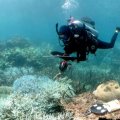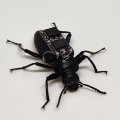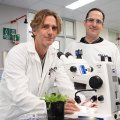The big questions of death, sex, evolution and fish will all be on the table at a University of Queensland public lecture on April 8.
Head of Sciences at Victoria Museum and 2008 winner of the Australasian Science prize Dr John Long will enthral audience members with details of his remarkable discoveries at the School of Biomedical Sciences’ Annual Public Lecture.
His lecture titled Death, Sex and Evolution: 380 million year-old fossil fish and the origin of the human body plan will recount his discovery of the oldest known example of live birth and the similarities between ancient fish and early land animals.
Dr Long was the 2008 Australasian Science Prize winner for his discovery of a remarkable fish fossil in Western Australia’s Gogo Formation that contained an intact embryo and mineralised umbilical cord – pushing back the known record of live birth some 200 million years.
The 375 million-year-old fossil of a 25-cm long placoderm fish belonged to the dominant group of vertebrates, sometimes dubbed “dinosaurs of the sea”, throughout the Middle Palaeozoic era, and has been named Materpiscis attenboroughi after renowned naturalist Sir David Attenborough.
Providing a major insight into the breeding behaviour of an entire class of extinct species, the discovery of the fish fossil was a major breakthrough in palaeontology and constitutes the oldest example of vertebrate sex unearthed to date.
Dr Long’s team also uncovered a complete fish fossil known as Gogonasus – meaning “snout from Gogo” – that showed unexpected features similar to early land animals.
The findings confirm that internal reproduction and live birth were much more widespread than previously thought.
The lecture will be held at the Institute for Molecular Bioscience Auditorium, UQ St Lucia campus, 5.30pm on Wednesday, April 8.
Media: Travis Taylor (07 3365 8598 or t.taylor1@uq.edu.au).
.jpg)



